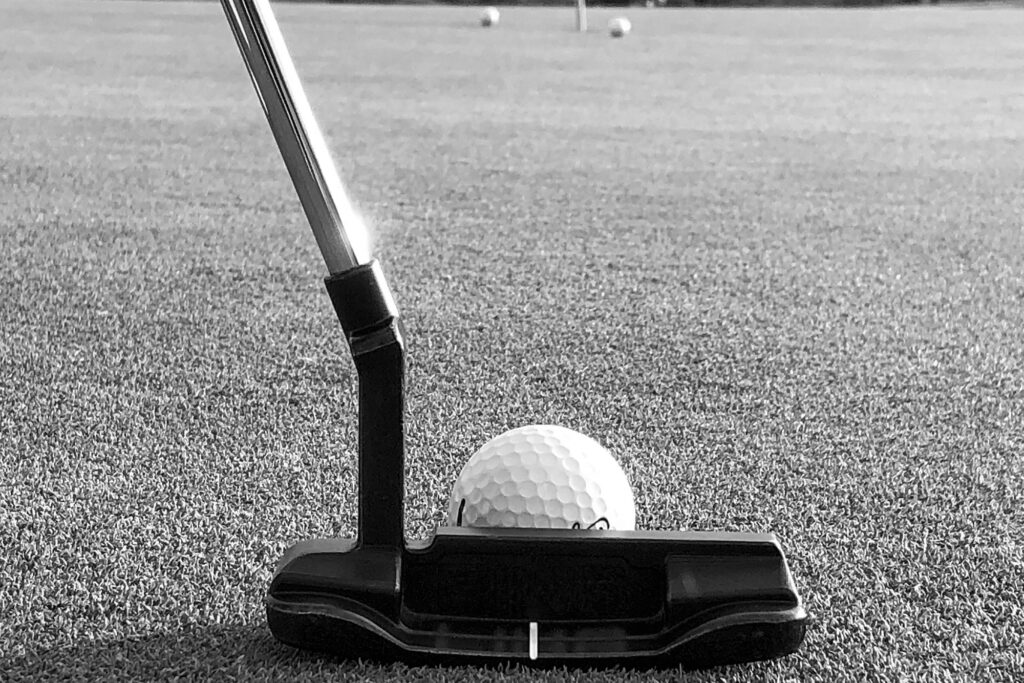Perceived pressure in golf
- Andreas Schwaab
- Sports

“The mind messes up more shots than the body.”
- Tommy Bolt (1916-2008)
On paper, golf appears to have straightforward rules: get a 43mm diameter ball into a 108mm diameter hole within the course’s boundaries with as few strokes as possible. Yet, paradoxically, this simplicity is what makes golf one of the most anxiety-inducing sports. Over the years, golf has provided unforgettable moments of players losing commanding leads in the final holes, revealing how quickly the mental game can unravel under pressure [1,2].
Is the putt the most important stroke in golf?
”I think pressure is a privilege and I have earned the right to feel that pressure. That is the way I try to view it and not to overcomplicate it too much“– Ludvig Åberg [3]
During our training together, Ludvig captured the essence of an elite mindset under pressure. But why does pressure in golf intensify so quickly, often leading to the notorious “choking under pressure”? One reason lies in the extremely tight margins in professional golf, where many players may be tied in rankings, sharing prize money for a given position. When the tournament reaches its climax, it often comes down to the final putts. Since professionals excel in their long game, a single missed or made putt can determine the difference between winning a title or losing hundreds of thousands of dollars. That there is truth behind this saying in golf ”Drive for show, putt for dough“ proves a dataset from the 2022 PGA Tour, that putting is more important in earning money than driving off the tee [4]. The pressure professionals are feeling with so much money on the line for one single shot can be overwhelming and shows that even elite athletes can be susceptible to pressure. This showed a study using a dataset from the PGA Tour from 2004 to 2012, that on the last hole of a tournament, the likelihood of making a putt significantly reduced, the more money, making the putt, could be earned [5].
Intense perceived pressure can lead to avoiding losses.
When humans start to behave irrationally based on a flawed subjective perception and not the objective input, they succumb to what is psychologically called cognitive biases [6]. Here, the pressure on golfers of not wanting to lose a stroke to the competition during putting leads to the cognitive bias of loss aversion [7]. It has been shown that golfers would rather play a putt safely when they have a chance for birdie in order to make par at a high percentage, especially when having the option of taking a risk to gain a stroke due to a three putt [8]. Conversely, when attempting to save par, golfers tend to take riskier putts to avoid a bogey. This loss aversion costs the average professional about one stroke per 72-hole tournament, and the top 20 golfers about $1.2 million in prize money a year [9]. However, top golfers can also perform at their peak under pressure, seemingly sinking every putt when it matters most. The better golfers play, the more they overestimate the diameter of the hole while putting [10], meaning it feels easier for them to putt.
Through our neuropsychological training and analysis on and off the course, we help golfers develop personalised routines that reduce perceived pressure and allow them to get mentally into ‘The Zone’. This mental edge can make the difference between a successful or a missed crucial shot or putt.
Our Advice: Be as clear as possible about your own mental processes before you find yourself in a high-pressure situation. Board and card games are a great example of an excellent way to get to know yourself better, as you have to playfully decide how much risk you want to take in order to win. Get to know your personality better and use this knowledge as an advantage in competition.
#trainyourbrain
If this article sparked your interest and you would like to know more about this or other topics, please do not hesitate to contact us via info@neuro11.de. We look forward to hearing from you.
References
[1] Video of major chokes in golf history: Link
[2] Video of the last round of the US Open 2024: Link
[3] Youtube video with Ludvig Åberg: Link
[4] Model of the highest earning shot in golf: Link
[5] Journal of Economic Behavior & Organization article: Link
[6] Wikipedia “Cognitive bias”: Link
[7] Wikipedia “Loss aversion”: Link
[8] University of Wharton article: Link
[9] Loss aversion in golf and business: Link
[10] Psychonomic Bulletin & Review article: Link
